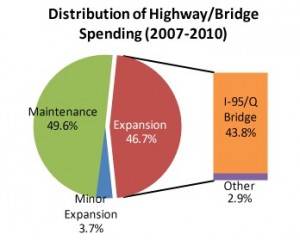The Tri-State Transportation Campaign’s efforts to advance 21st century transportation policies in Connecticut are bearing fruit.
The Connecticut Department of Transportation (ConnDOT) is spending more on road and bridge repair, public transportation, and cycling and walking projects, according to a TSTC analysis released today.
Tracking the Dollars: A Review of Projected Transportation Spending in Connecticut, 2010-2013, is based on an exhaustive analysis of the 2010-2013 Statewide Transportation Improvement Program (STIP) and comparison to previous transportation plans. The STIP is the best single source of information about the state’s transportation spending decisions.
In the past, TSTC has criticized ConnDOT for building expensive new highway projects at the expense of existing roads and bridges and other transportation options. (Connecticut has some of the worst roads in the nation, with more than 75 percent of the state’s major roadway lane miles in “less than good” condition and over 33 percent of the state’s bridges rated as deficient.) But this new analysis shows that under Commissioner Joseph Marie’s leadership ConnDOT has begun to shift dramatically towards sustainable 21st century transportation policies, a shift which should be reflected in gradually improving road and bridge conditions.

Specifically, road and bridge repair and maintenance now accounts for 49.6 percent of all highway and bridge spending, up from just 36 percent in the 2007-2010 STIP. Spending on expansion projects has dropped from 61 percent in the 2007-2010 plan to 46.7 percent in the current STIP.
The report also finds that Connecticut is spending more on transit, bicycle and pedestrian projects. The share of funding dedicated to transit capital projects is up to 39 percent of total capital spending, from 36.6 percent in the 2007-2010 STIP. Bicycle and pedestrian projects now constitute 1.1 percent of transportation capital spending, up from 0.9 percent in the previous STIP.
Still, the report finds plenty that ConnDOT can do to build upon these gains. Specifically, it recommends:
- Continue to Fix-it-First: ConnDOT should reduce the size of future components of the massive Q-Bridge reconstruction project and divert excess funds to road and bridge maintenance. Going forward, the state should cap spending on highway expansion projects at 5 percent of overall transportation spending.
- Develop more effective tools to manage congestion: The state should consider sustainable congestion relief measures, including more coordinated and efficient land use planning and roadway pricing along the most heavily-traveled routes.
- Continue efforts to create a robust bicycle and pedestrian program: ConnDOT and the Connecticut General Assembly should pre-designate 10 percent of two flexible federal funding programs (the Highway Safety Improvement Program and the Congestion Mitigation and Air Quality Improvement Program) to bicycle and pedestrian projects and new initiatives like Safe Routes for Seniors and Safe Routes to Transit. This would add approximately $4 million a year to bicycle and pedestrian project spending.
- Ensure greater transparency at ConnDOT: ConnDOT should combine all federal and state expenditure plans into a single, easy-to-read document and modernize its website. This will enable the public to more accurately assess the state’s transportation priorities.
Link here for the press release and here for the full report.
